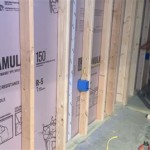What Is A Walkout Basement Foundation?
A walkout basement foundation represents a specific design in residential construction where one or more walls of the basement are entirely exposed to the exterior grade, allowing for a door and windows that provide direct access to the yard. This type of foundation is typically found on properties with sloping terrain. Unlike a standard basement, which is usually entirely or mostly underground, a walkout basement integrates more seamlessly with the outdoor environment, offering increased functionality and natural light.
The construction of a walkout basement foundation requires careful planning and execution due to its interaction with the surrounding landscape. The process involves excavating the basement area into the slope of the land, ensuring proper drainage, and constructing the foundation walls. The exposed wall or walls are built to accommodate a door and windows, effectively creating an above-ground entrance and exit point. The remaining walls may be partially or fully underground, depending on the slope and design.
The primary advantage of a walkout basement lies in its enhanced usability. The direct access to the exterior allows the space to be used for various purposes, such as a recreational area, a guest suite, or even a rental unit. The presence of natural light and ventilation contributes significantly to the overall comfort and livability of the basement, making it feel less like an underground area and more like an extension of the main living space.
Several factors influence the feasibility and cost of constructing a walkout basement foundation. The slope of the land is a crucial determinant, as it dictates the extent of excavation and grading required. Soil conditions and drainage are also critical considerations, as they affect the stability of the foundation and the risk of water damage. Local building codes and regulations must be adhered to, ensuring that the construction meets safety and structural standards. These factors contribute to the overall complexity and expense of the project, requiring careful evaluation and planning.
Walkout basements are most commonly found in areas with significant topographical variation. Regions with hills, valleys, or rolling landscapes offer natural opportunities for building walkout basements. These geographical features allow for the necessary slope to create the exposed wall and direct access to the outdoors. The design is less practical in flat areas, where extensive excavation and landscaping would be required to achieve the same effect, potentially increasing costs and construction complexity.
The design and construction of a walkout basement foundation necessitate a thorough understanding of engineering principles and building practices. Proper site grading is essential to ensure that water is directed away from the foundation, preventing potential water damage. The foundation walls must be designed to withstand lateral earth pressure and resist moisture penetration. Insulation is crucial to maintain a comfortable temperature and reduce energy consumption. Careful attention to detail in all aspects of the construction process is vital to ensure the structural integrity and longevity of the walkout basement foundation.
Key Point 1: Enhanced Functionality and Usage
The most compelling advantage of a walkout basement foundation is the enhanced functionality and versatility it offers. Unlike traditional basements, which are often perceived as dark and damp storage spaces, walkout basements can be transformed into fully functional living areas. The direct access to the exterior through a door and windows allows for easy entry and exit, making the space suitable for various uses such as:
Recreational Area: A walkout basement can be converted into a game room, home theater, or entertainment space. The direct access to the backyard makes it easy to transition between indoor and outdoor activities.
Guest Suite: The presence of a separate entrance and windows allows for the creation of a private guest suite, complete with a bedroom, bathroom, and living area. This provides visitors with a comfortable and independent space.
Home Office: The natural light and ventilation in a walkout basement can create a productive and comfortable workspace. The separate entrance can also be beneficial for clients or employees visiting the office.
Rental Unit: In some cases, a walkout basement can be legally converted into a rental unit, providing an additional source of income for the homeowner. This requires compliance with local zoning regulations and building codes.
The increased functionality and usage of a walkout basement significantly enhance the value and appeal of the property. It provides homeowners with more living space and greater flexibility in how they use their homes.
Key Point 2: Natural Light and Ventilation
One of the significant drawbacks of traditional basements is the lack of natural light and ventilation. This can make the space feel claustrophobic and uncomfortable. Walkout basements address this issue by incorporating windows and a door that allow natural light and fresh air to enter the space.
The presence of natural light in a walkout basement can significantly improve the overall ambiance and comfort of the space. It can make the basement feel brighter, more spacious, and more inviting. Natural light can also have positive effects on mood and productivity, making the basement a more enjoyable place to spend time.
Adequate ventilation is also crucial for maintaining a healthy and comfortable environment in a basement. Walkout basements provide natural ventilation through the door and windows, which can help to reduce moisture buildup and prevent mold growth. Proper ventilation can also improve air quality and reduce the risk of respiratory problems.
The combination of natural light and ventilation in a walkout basement creates a more livable and functional space compared to traditional basements. It makes the basement feel less like an underground area and more like an extension of the main living space.
Key Point 3: Construction Considerations and Cost Factors
The construction of a walkout basement foundation involves several considerations and cost factors that must be carefully evaluated during the planning and design phases. These factors can significantly impact the overall cost and complexity of the project.
Slope and Topography: The slope of the land is a primary determinant of the feasibility and cost of building a walkout basement. Steeper slopes may require more excavation and grading, increasing the cost of the project. Gentle slopes are generally more ideal for walkout basements, as they minimize the amount of excavation required.
Soil Conditions: The type of soil present on the property can also affect the cost of construction. Unstable soil may require additional reinforcement of the foundation walls, adding to the overall expense. Soil testing is essential to determine the soil's bearing capacity and stability.
Drainage: Proper drainage is crucial for preventing water damage in a walkout basement. The site must be graded to direct water away from the foundation walls. Drainage systems, such as French drains and sump pumps, may be necessary to manage groundwater and prevent flooding. The cost of drainage systems can vary depending on the site conditions and the type of system installed.
Building Codes and Regulations: Local building codes and regulations must be adhered to during the construction of a walkout basement. These codes may specify requirements for foundation design, insulation, ventilation, and fire safety. Compliance with building codes can add to the cost of the project, but it is essential for ensuring the safety and structural integrity of the building.
Materials and Labor: The cost of materials and labor will also impact the overall cost of the walkout basement. The type of foundation material used, such as concrete or concrete block, can affect the cost. Labor costs will vary depending on the location and the availability of skilled workers.
Careful planning and budgeting are essential for managing the costs associated with constructing a walkout basement foundation. Consulting with a qualified architect, engineer, and contractor can help to identify potential challenges and develop cost-effective solutions.
In addition to the above considerations, the market value of homes with walkout basements tends to be higher, which can offset the initial construction costs over time. This potential increase in property value is related to the improved usability and desirability of the space.
The success of a walkout basement construction project hinges on a comprehensive understanding of site conditions, adherence to building regulations, and skillful execution of construction processes. Engaging experienced professionals is crucial to navigating the complexities involved and ensuring a structurally sound and functional outcome.

Walkout Basement

Foundation Type

Walk Out Foundation Frost Free Design Concrete Facts Magazine Online

How Much Slope For A Walkout

Walk Out Basement Foundation With Frost Wall Is This Bad Greenbuildingadvisor
.jpg?strip=all)
Foundation House Building Update No 4 Arrow Hill Cottage

How To Build A Walkout Basement In Your Home Harris Excavation

Daylight Vs Walk Out Basements Monster House Plans Blog

3 Types Of Basement Foundation Pumpspy Store

Basement Walkouts And What You Need To Know Avelar Home Inspection Inc







